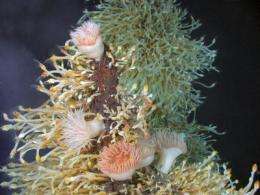Finding life in the volcanic systems of the Antarctic Polar Front

Volcanic waters in the cold Southern Ocean are the destination for RRS James Cook's current expedition. Scientists are exploring a two-mile deep water system of hydrothermal vents, calderas and cold seeps on the seabed off the coast of Antarctica.
Led by Prof Paul Tyler of the University of Southampton Ocean and Earth Science, which is based at the National Oceanography Centre, the scientists are investigating four sites that were discovered on an earlier expedition to the region. The underwater East Scotia Ridge at the southern end of the South Sandwich Islands is a complex tectonic system that includes black smokers, white smokers, cold seeps and volcanic craters. It is the animal communities at that populate these chemosynthetic habitats that are interesting the scientists.
Prof Tyler said: "We will be using a deep-diving ROV called Isis to film and sample how these animals interact with the vents. The water here is super-heated to around 300 degrees Centigrade, instant death if the creatures get into the vent plume.
"But what intrigues us the most is how these species differ from species found at other vent sites around the world. We are investigating another piece of the biogeochemical puzzle that makes up the pattern of vents around the globe. We have a team of biologists, chemists, geologists and data experts who will map and explore this system."
While on board, the scientists will be contributing to a daily blog called Hot Vents, Cold Ocean: http://hotventscoldocean.blogspot.com. They will be posting videos and daily observations about their work in the world's most remote ocean – the East Scotia Ridge at the southern end of the South Sandwich Islands.
The scientists are drawn from a number of institutes, the National Oceanography Centre, British Antarctic Survey, the Natural History Museum and the Universities of Leeds, Newcastle, Southampton and Oxford. The expedition is the latest in a series of cruises to the region as part of a consortium programme called ChEsSo – Chemosynthetic Ecosystems of the Southern Ocean set up to explore vents south of the Polar Front.
The team will be using Isis, the UK's deep-diving ROV (remotely-operated vehicle). Although capable of diving to ocean depths of 6500 metres (4 miles), on this expedition Isis will be working at 2800m (just under 2 miles). High definition cameras will reveal and record the animals living at these sites.
The expedition ends on the 5th January when RRS James Cook reaches Montevideo in Uruguay.
Provided by National Oceanography Centre, Southampton (UK)



















